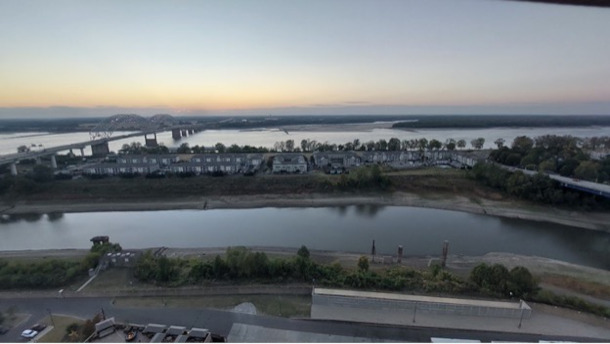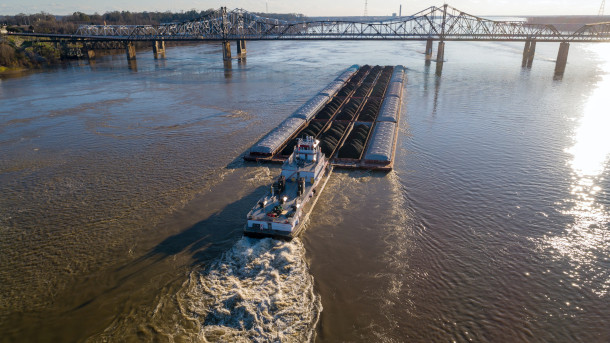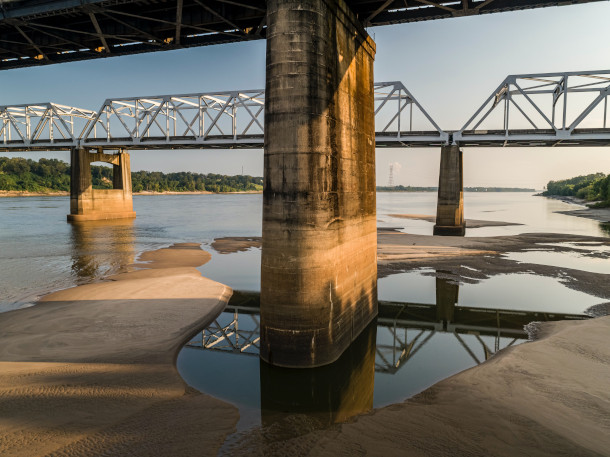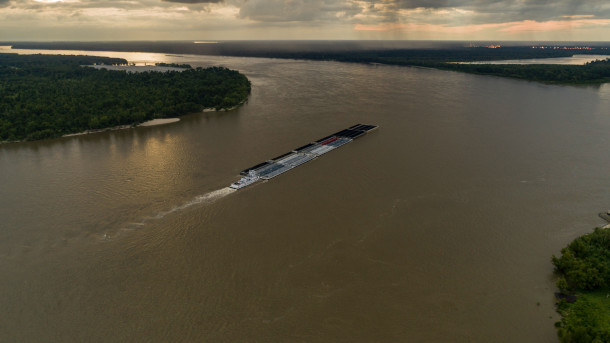Maybe Like Dust Bowl Days? Low Water on the Mississippi
Air Date: Week of December 2, 2022

The Mississippi’s reduced volume is evident in the sandbars on either side of this stretch of the river in Memphis. Water levels in some parts of the river have dropped to record lows. (Photo: Courtesy of Kharisher Kahfi)
Shallow water linked to years of drought has severely limited navigation on the Mississippi River, making it harder for farmers to get their corn, soybeans and wheat to market. Chad Hart is a professor of Agricultural Economics at Iowa State University in Ames and joins Host Steve Curwood to talk about the climate connections with the midwestern drought similar to the Dust Bowl Era and how it’s affecting food commodities.
Transcript
CURWOOD: Climate disruption is being blamed at least in part for a traffic jam. But in this case, it’s not cars and trucks that are backed up but the massive barge traffic on America’s biggest waterway, the Mississippi River. US commodity crops of corn, soybeans and wheat are a $100-billion business, and nearly 80 percent of US global exports of feed grains and soybeans are produced in the Mississippi Basin. This fall and early winter shallow water linked to years of drought has severely limited navigation and that means barges carrying corn and soybeans produced this year in the Midwest are taking much longer to thread their way past the shoals and sandbars to the port of New Orleans. Farmers are getting 10 or even 20 percent less per bushel for corn and soybeans when they do finally get their crops loaded on a barge, while the export buyers are paying much higher prices for the limited supplies that do make it downriver. Wheat is also affected, but less so as much is milled into flour close to where it’s grown. But problems linked to the Mississippi don’t end at the export docks. And as climate change continues to exacerbate drought conditions around the world, the barge backup along the Mississippi River also affects international food markets. For more I’m joined by Chad Hart. He’s a professor of agricultural economics at Iowa State University in Ames. Welcome to Living on Earth!
HART: It's my pleasure to be with you today.
CURWOOD: Now over half of the Mississippi River is having some kind of drought. Of course with less water, the barge system that transports a lot of goods, particularly I'm thinking of the corn and soy and some of the wheat is having some problems, just how important is the Mississippi River to getting U.S. crops from the fields to where it needs to go?

A tugboat pushes barges down the Mississippi River near Vicksburg, Mississippi. (Photo: Justin Wilkens on Unsplash)
HART: It is critically important because when you think about the crops that we grow here in the upper Midwest, anywhere from, you know, my home state of Missouri, through Iowa, Illinois, Indiana, even Minnesota, the Dakotas, a lot of that crop is sent down the Mississippi River to reach especially our international export markets. So when you think about our corn, soybeans, and wheat production, we create a lot of excess production here within the U.S., meaning that domestic demand is not enough to eat through all of that crop. So we do ship tremendous amounts of our crops to the rest of the world. And the Mississippi River is the main conduit to move our product from the interior of the country, out to the border where we can then reach those other markets.
CURWOOD: Of course, the Mississippi has more water and less water at certain times. How big is this drought? Just how much has the Mississippi during the shipping season shriveled up compared to what usually happens?
HART: Well, when we look right now yet, yeah, you're right, there is a seasonality to the level that we see within the river. And right now tends to be one of those times where we do see our lower levels within the year. But what we're seeing right now is historically low. The best way I can describe it is, you know, we're starting to see artifacts that haven't surfaced literally within the last 150 years that are now brought to the surface because the water levels have dropped so far.
CURWOOD: I mean, farming, of course, is always an uncertain business. And there's variability but this sounds like extreme variability. To what extent is this related to climate disruption, do you think?

A bridge over the Mississippi reveals how far waters have receded. A shallow river supports less boat traffic, creating an uphill battle for farmers trying to ship their harvests. (Photo: Justin Wilkens on Unsplash)
HART: Well, I think that's the deal. When we're looking at this type of impact from a drought, it isn't just a single year drought. This is because we have seen the drought that has been within the western U.S. has been here for quite some time, but has really started to extend into the Midwest over the last three years. So we are seeing significant multi-year drought impact on the river system, like you say, you know, dropping it to levels we literally have not seen in over 150 years. It's something we really haven't experienced. And it's hard to point to anything other than, you know, climates are changing, we are getting warmer and more extreme within our weather. And that is starting to show up not only in the short run impacts that we're seeing within our weather systems, but in these longer run ramifications of multi-year droughts. Especially here within the Midwest, the most, if you will, consistent signal to tell us how the drought is going to proceed is the El Niño/La Niña cycle. And what we find ourselves in right now is a multi-year La Niña phase and La Niña tends to, if you will, lock in weather patterns across the Midwest here. We're in our third year of that now, the projections are that La Niña will last through the winter. But we may return to what's called neutral conditions by next spring.
CURWOOD: Yeah, and yet La Niña, the three year persistence is–I don't know if it's completely unprecedented, but it's certainly very rare.
HART: It's, well, it's somewhat rare. We've seen... If you go back into the data, we we had a stretch in the early 1970s where we saw this but we didn't have as significant a drought or longer term drought as we did now. We had another period in the 50s, but the one that I'd say most people think is, if you will, the parallel to this one would be the Dust Bowl era that we saw in the 1930s.
CURWOOD: Wait a second, a hair just went up on the back of my neck. We could be looking at a new dust bowl, I hear you suggesting?
HART: No, I wouldn't say that. But the idea is that when you think about the Dust Bowl and the drought that we saw with that it was related to a three to four year La Niña cycle back then as well. I think the big differences here are, when we think about the Dust Bowl era versus today, we have changed our agricultural production systems greatly since then. And so we're not seeing the production impacts like we saw back from the 1930s. We have changed how we produce, what we produce, and those changes have been to the benefit of our production within a drought system. At the same time, too, though, the weather pattern itself is similar to what we saw during the Dust Bowl era.

A boat pushes barges upriver. Transportation difficulties are predicted to raise the price of goods manufactured with wheat, corn, and other Midwestern crops in areas distant from where the crops are grown. (Photo: Justin Wilkens on Unsplash)
CURWOOD: And so what's spooky is that in 1928 or so there were these massive floods on the Mississippi followed by the Dust Bowl. And what, two, three, four years ago, we had massive flooding on the Mississippi and now this massive drying.
HART: Yeah, and–well, I think that points out though, that's why I would say you still see discussion about "Is this truly from climate change or not?" is because we have seen periods like this in the past. But we typically have to go back 80, 90, 100 years in order to find those closest parallels as we look out there. But I think what is more concerning is, as you say, the frequency that we do see more extreme weather events seems to be becoming greater as we look at our most recent weather patterns compared to the historical.
CURWOOD: With the long-term drought really affecting the Mississippi, how does this change the agriculture business? You know, people usually plan on the basis of projecting from the past. But now the past may not be such a great guide as we go into this relatively uncharted climate territory. I bet 10 years ago, you wouldn't have...we wouldn't have been talking about the Mississippi running fairly dry.
HART: We probably wouldn't. At the same time, too is, it probably will not change in the short run, at least, what farmers are planting or how they plant it. But I think it does bring up this issue of looking at not only the production risk–so this idea of that we normally think of droughts impacting as you say, the production of the crop, how big the crop is, what the yield is for that farmer. What this shows is that weather has other indirect impacts on the farmers' decision. It's no longer just a worry about the production impacts of a drought, but now you've got to look at–let's call it the marketing/financial burden of a drought that can happen here. Because what's happening with the Mississippi hasn't truly impacted their ability to produce, but it is impacting the farmers' ability to market their crop and receive a price strong enough to cover the cost of their production.
CURWOOD: Chad Hart is a professor of Agricultural Economics at Iowa State University in Ames. Professor, thanks so much for taking the time with us today.
HART: Thank you very much, sir.
Links
Sign up for a webinar about current conditions on the river and the plan moving forward here:
NOAA’s latest monthly climate report
Read more about how the Mississippi River drought is affecting the grain industry here:
Follow the link to learn more about how drought impacts agriculture:
Living on Earth wants to hear from you!
Living on Earth
62 Calef Highway, Suite 212
Lee, NH 03861
Telephone: 617-287-4121
E-mail: comments@loe.org
Newsletter [Click here]
Donate to Living on Earth!
Living on Earth is an independent media program and relies entirely on contributions from listeners and institutions supporting public service. Please donate now to preserve an independent environmental voice.
NewsletterLiving on Earth offers a weekly delivery of the show's rundown to your mailbox. Sign up for our newsletter today!
 Sailors For The Sea: Be the change you want to sea.
Sailors For The Sea: Be the change you want to sea.
 The Grantham Foundation for the Protection of the Environment: Committed to protecting and improving the health of the global environment.
The Grantham Foundation for the Protection of the Environment: Committed to protecting and improving the health of the global environment.
 Contribute to Living on Earth and receive, as our gift to you, an archival print of one of Mark Seth Lender's extraordinary wildlife photographs. Follow the link to see Mark's current collection of photographs.
Contribute to Living on Earth and receive, as our gift to you, an archival print of one of Mark Seth Lender's extraordinary wildlife photographs. Follow the link to see Mark's current collection of photographs.
 Buy a signed copy of Mark Seth Lender's book Smeagull the Seagull & support Living on Earth
Buy a signed copy of Mark Seth Lender's book Smeagull the Seagull & support Living on Earth

